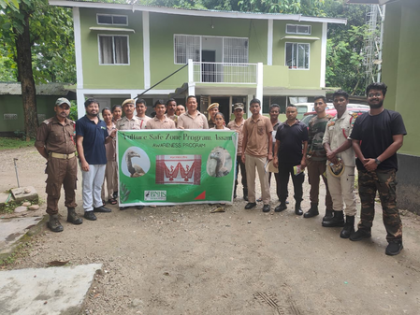Kaziranga National Park undertakes multiple initiatives for vulture conservation
By IANS | Updated: September 7, 2025 18:55 IST2025-09-07T18:50:56+5:302025-09-07T18:55:03+5:30
Guwahati, Sep 7 Kaziranga National Park and Tiger Reserve (KNPTR), India’s seventh UNESCO World Heritage Site, has undertaken ...

Kaziranga National Park undertakes multiple initiatives for vulture conservation
Guwahati, Sep 7 Kaziranga National Park and Tiger Reserve (KNPTR), India’s seventh UNESCO World Heritage Site, has undertaken multiple initiatives for vulture conservation, an official said on Sunday.
KNPTR Director Sonali Ghosh said that with technical and financial support from the Central Zoo Authority (CZA) and partnering agencies, about 800 vultures are currently housed across eight conservation breeding centres in the country. As such, the Centre, Assam government and the Bombay Natural History Society (BNHS) are considering releasing captive-bred vultures into Kaziranga Tiger Reserve and currently, the process and planning for the same is ongoing, the KNPTR Director said.
Ghosh said that the CZA permissions come through, it is proposed to release 30 white-rumped vultures and five slender-billed vultures from the Vulture Conservation Breeding Centre, Rani, in Assam’s Kamrup district to the Nagshankar range under the 6th addition to Kaziranga National Park. The aviary at the soft-release site is under construction, and awareness activities such as these are being conducted with the local communities, she said.
According to the official, vulture populations in India are gradually recovering from the catastrophic population crash that has occurred since the mid-1990s. The population crash was driven by unintentional poisoning by the non-steroidal anti-inflammatory drug (NSAID), diclofenac, she said.
The KNPTR Director, however, said that the veterinary use of diclofenac has been banned in India, and elsewhere in South Asia, other vulture-toxic NSAIDs are available, such as Aceclofenac, Nimesulfide and Ketoprofen. Through the consolidated strategy under Action Plan for Vulture Conservation in India, 2020-2025, and the active intervention by the Ministry of Environment, Forest and Climate Change (MoEF&CC), Assam Forest Department, and the BNHS, conservation breeding success has been achieved for three species of critically endangered vultures, namely, the white-rumped vulture, long-billed and slender-billed vulture.
Ghosh said that on the occasion of ‘International Vulture Awareness Day’, the KNPTR organised a Vulture Awareness Talk on Sunday at the Kaziranga office, Bokakhat. The programme witnessed the participation of 35 students from J.D.S.G. College and C.N.B. College, Bokakhat, who engaged actively in the discussions. The session was also streamed live on the official Facebook page of Kaziranga National Park, enabling a wider audience to participate virtually and spread awareness about vulture conservation.
The gathering was led by Gitartha Borah, Biologist, BNHS, who delivered an interactive talk on the ecological importance of vultures, their rapid population decline due to threats like diclofenac poisoning, and the conservation efforts being undertaken in Assam and across India to revive these critically endangered species. The event emphasised the crucial role vultures play as nature’s clean-up crew in maintaining ecological balance and public health.
Students also interacted with the resource person, raising questions on vulture breeding, habitat protection, and the significance of safe zones such as the Vulture Safe Zone initiative in Assam.
The Kaziranga National Park and Tiger Reserve, and its adjoining landscape, continue to be one of the most important strongholds for vulture populations in India, and community involvement remains key to their survival, Ghosh pointed out.
Disclaimer: This post has been auto-published from an agency feed without any modifications to the text and has not been reviewed by an editor
Open in app